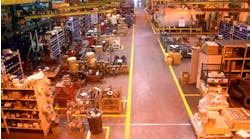Building climate control is perhaps one of the greatest inventions since the industrial revolution. The ability to have your indoor space untouched by the great outdoors and set to a fixed temperature and humidity is a wondrous thing. It’s made mankind's expansion across the globe prolific and widespread while also providing comfort.
Yet like most machines with moving parts, HVAC systems generate noise, and with this noise comes certain disturbances. We all know the sound of a fan or a refrigerator's compressor; those are HVAC noises.
For the most part, if a building space has a mixed variety of mechanical noises, blending together to become white noise (think ocean waves or wind in trees), it can be pleasant and soothing. However, when loud mechanical noises stand out in both frequency and amplitude for long periods of time, it can become distracting, disturbing and unhealthy.
HVAC Noise Sources
Rumble
Rumble is a common HVAC noise issue. It's a low-frequency noise transmitted both airborne and vibrationally, like a passing train or truck. Rumble makes it very hard to focus for any length of time. The solution is twofold:
- Clean the fan blades on the air handler, balance the spindle, lubricate the bearings and treat it like a wheel on an electric car with precision and detail to insure it spins smoothly and silently. It’s easier said than done, as fans can be very large and heavy with gears and bearings buried deep inside the air handler.
- Isolate both the air handler and compressor (or chiller) mechanically from the building structure. This is typically done using spring isolators either floor mounted or ceiling hung.
Remember as there is still a mechanical connection there will still be noise. It will be considerably less, but the HVAC will need to be in its own isolated room with its own engineered acoustic isolation and air supply and returns.
Ducting
Ducting is a common source and transmitter of noise. From the air handler to the vents, ducts connect everything as the "pipeline" of air to each room. While they perform this function well, they also funnel the noise from the air handler (fan blades) and the friction of the air itself moving through the duct down to the room, depositing all the sound in the space being cooled or heated. Sound traps control the airborne noise in a duct while allowing the air itself to continue onward.
Ducts can also be lined with insulating material, which keeps the sounds inside the duct and the air friction noise to a minimum. The expansion and contraction of the metal duct itself can become an issue, making noises when the metal contracts and expands with temperature. The solution to this can be more complex than a product, so please contact your local acoustician and HVAC specialist.
Another simple solution to decrease HVAC noise is to use a ductless mini-split unit. These wall or ceiling-mounted units, popular overseas, have evolved into efficient, quiet and effective HVAC systems even on a larger scale. The compressor connects directly to the unit, which pushes the air with fans and louvres for dispersion. The lack of ducting saves labor, money and time while also removing a source of acoustical issues. Over time these units have become quieter.
Importance of Improving HVAC Noise
In architecture, one challenge with HVAC noise is to design for code minimum vs. human perception. Code minimum by definition will adhere to and meet the local building codes and regulations. However as sound and acoustics are generally not enforced, nor given much priority these minimums are far below the hearing threshold.
Building to code minimum might mean people still hear a great deal of noise and vibration after the fact. Intrinsically, we expect complete silence when we sleep, true quiet when on vacation, and low ambient noise when having a conversation or making a phone call. These everyday circumstances require excellent acoustics and quiet surroundings.
Acoustics is driven by human need. If you can't have a conversation with the person next to you, then there’s a need for acoustics to make that conversation possible. On the flip side, we’ve also all been somewhere so quiet you can everything anyone says far away. The goal is to create acoustical spaces that are conducive to human function everywhere
The industrial revolution gave us wonders of technology and a new standard of living, but also gave us more noise than ever existed.
Work With Experts to Find a Solution
If you have an HVAC issue, communicate clearly with your maintenance staff to create an effective solution.
HVAC systems are wondrous in their ability to control our climate and improve our quality of living. Their complexity requires a good acoustician and an excellent HVAC engineer with true understanding of acoustics and air flow.


